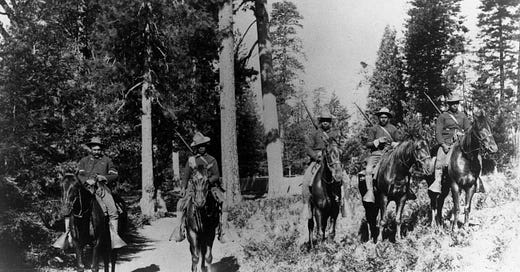The Land Was Never Free
As conservationists, Juneteenth calls us to reckon with the exclusion of Black Americans from the land they labored on—and to build a future where public lands serve all.

On June 19, 1865—more than two years after the Emancipation Proclamation—enslaved people in Texas were finally informed of their freedom. Juneteenth marks that long-delayed moment of liberation, and the long, unfinished struggle to make freedom real through land, rights, and self-determination.
Public lands are often described as America’s shared inheritance—but that inheritance began with the displacement and dispossession of Indigenous peoples. After the land was taken, Black Americans—despite centuries of labor, military service, and stewardship—were systematically denied equal access to it.
After the Civil War, formerly enslaved people were promised "forty acres and a mule"—a short-lived federal policy of land redistribution that was quickly rescinded. The Homestead Acts, which ultimately transferred over 270 million acres of public land into private hands, were in theory open to “citizens or those intending to become citizens.” But enslaved Black people were not considered citizens under U.S. law.
Only after the ratification of the 13th Amendment (which abolished slavery in 1865) and the 14th Amendment (which granted birthright citizenship in 1868) were formerly enslaved people legally eligible to file homestead claims. Even then, racist violence, discriminatory land office practices, and lack of access to capital and legal support made land acquisition nearly impossible for most Black families.
“Although the Homestead Act was theoretically open to all citizens after 1866, including African Americans, discrimination in land offices, lack of access to capital, and organized violence ensured that very few Black homesteaders could take advantage of it.”
— Mark Fiege, The Republic of Nature (2012)
Some Black homesteaders did succeed—especially in the Great Plains—but they were the exception. Today, Black farmers own less than 1% of agricultural land in the United States, down from over 16 million acres in 1910. Black communities remain underrepresented in both land access and land use decision-making, with limited opportunities to shape how public lands are managed, conserved, and made accessible.
National parks were created on lands taken from Indigenous peoples, then maintained by Black soldiers—the Buffalo Soldiers—who served as some of the first park rangers. Yet under Jim Crow, Black families were often barred from visiting these very parks, or segregated into areas that received inferior services. The legacy of exclusion runs deep—even in the wild places meant to symbolize national belonging.
For conservationists, Juneteenth should be a reminder that justice on the land is inseparable from racial justice.
As we fight to protect wild ecosystems from corporate exploitation, we must also fight to democratize how these lands are governed. Public lands should not just be accessible—they should be shaped by the people who’ve been systemically excluded from land ownership, stewardship, and policy decisions for generations.
That means confronting the legacy of land theft, exclusion, and extraction. It means ensuring that Black, Indigenous, and other marginalized communities have a real seat at the table—in local land use planning, in federal policy, in conservation leadership.
Because liberation without land is unfinished freedom. And land without justice is not truly public.
Grace Kuhn is the Digital Director for Western Watersheds Project. grace@westernwatersheds.org





Thank you for this post
A really excellent choice for today, and a thought to carry — everyday. Thank you